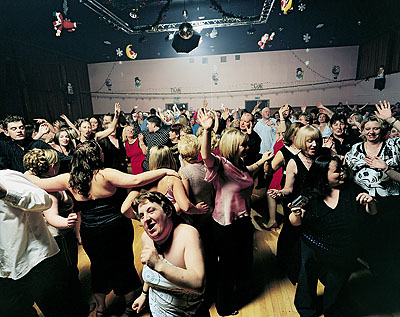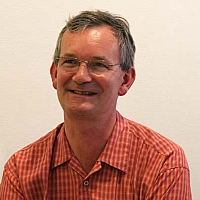
Betty at Port Glasgow Town Hall Xmas Party' ( c-print, 2005),
Haus der Kunst Prinzregentenstrasse 1 80538 Munich Allemagne
The fact that Parr, who is a member of the legendary photography agency Magnum, is a collector himself is not generally known. 'Parrworld' places the artist's photographs in a dialogue with his collections, revealing cross-references and connections between these. Together these collections form a cabinet of media curiosities, which simultaneously express the psyche of its creator.
"I have a very strong collecting gene, and the pages of this book are testimony to this condition. It started early. When I was very young I gathered together a museum of items such as pellets (balls of fur and bones, spat out by birds of prey), fossils and birds' nests in the cellar of our semi in Chessington, Surrey. Over the years, these collecting habits have shifted and become more refined. I have collected stamps, bus tickets, Victorian pennies and, my biggest collection to date, photographic books." Martin Parr
His fascination with the trite and his preference for exceptions to rules, as well as for the unusual and peculiar, lend his collections their individual character.
Postcards
The works from this collection could almost describe an entire century. At a time when daily newspapers were not technically able to print photographs there was already a great demand for images that depicted current events. At the end of the 19th century, interest in the sensational led to the usage of the previously practised process of wood and copperplate engravings as photographic picture postcards, which served as a particularly prompt form of reporting and which were based on the method's quick and inexpensive method of production. A collection of these news images is the foundation of this postcard collection that Parr began to compile thirty years ago. Further focuses are studio portraits, images by the photographers Warner Gothard and John Hinde, vacation postcards and curiosities, such as 'boring postcards' depicting motorways, prefabricated buildings and interiors. This collection is an example of the changing way this simple, affordable and popular form of communication has been used. The postcards present their motifs in a condensed form, as an ideal, which is, of course, a construction by the photographer.
Objects
United in this collection are different types of objects, including items from the Soviet 'Sputnik era', Maggie Thatcher's reign, the pop band the Spice Girls' and from the attacks of 9/11, all of which represent events that have shaped our collective memory because of their presence in the media where photography plays a fundamental role. There is not a single everyday object or curiosity that has not been checked by Parr for its significance as a possible symbol for a certain zeitgeist. Objects from various sources are arranged thematically by the artist and can thus be read in a new manner: "I am very attracted to objects, which are ephemeral. Their significance and cultural context change as the world moves on. Many of these objects are associated with people or events that are locked into the glories of a certain time and place. When these glories fade, the object takes on a certain resonance that is the driving force of this collection".
Photography Books
Parr's unique collection of national and international books on photography addresses the medium of photography and the printed image. The collection shows the history of photography books based on a selection of particularly important or interestingly designed publications, from icons in book art to publications by lesser-known publishing houses.
All of photography's fields of application, from advertising to propaganda, from contract photography to artistic self-expression in a self-designed book, are presented here. Following Parr and Garry Badger's publication of their two volumes of 'The Photobook - A History', in 2004 and 2006 respectively, these photography books have become sought after collector's items. Also included in this section are book-dummies; book designs created by the artists for their publications, displayed here together with several original photographs.
Photography Collections
Parr's interest in social themes is also reflected in his collections of photographs, which are presented in a British and an international section. The first section is comprised of the most extensive private collection in Great Britain today. Here a selection of social-documentary positions with works from the 70s and 80s by artists such as Tony Ray-Jones, Chris Killip and Graham Smith can be seen. Artists such as Keith Arnatt, Mark Neville, Jem Southam and Tom Wood represent contemporary British photography.
The international part of this collection is represented by photographs that have influenced Parr or with which he has built up a personal relationship: images by such masters as Robert Frank, Garry Winogrand and William Eggleston are juxtaposed with works by friends including John Gossage and Gilles Peress. Another focus is made up of works by Japanese photographers, who are relatively unknown in Germany, such as Osamu Kanemura, Kohei Yoshiyuki and Rinko Kawauchi
Luxury
For his new series 'Luxury', Martin Parr travelled to international cities such as Dubai, Durban and Moscow, photographing fashion shows, art and luxury products fairs and horse races, as well as Munich's Oktoberfest. Modesty is not necessarily a pronounced characteristic of the representatives of the international jet setter scene, who proudly present the insignia of new money and superficial growth. Using the means of the grotesque, Parr now uncompromisingly focuses his attention on the phenomenon of a new international upper class following his earlier projects on the working and middle classes.
The artist's photographs, however, are not an example of the 'smile-shutter camera', nor do they poke fun at the expense of others. When the director Wim Wenders says that each camera photographs in two directions, then this fact is particularly true for Martin Parr and it is even part of the credibility of his work. The photographer himself even stresses that his works can be seen as a contemporary view of society, but also as a kind of self-portrait.
Two books will accompany the show: 'Objects' by Martin Parr (with an introduction by Martin Parr; Chris Boot Ltd; 176 pages, 500 objects illustrated, ISBN 978-1-905712-08-3) and 'Postcards' by Martin Parr (with an essay by Thomas Weski; Chris Boot Ltd; 336 pages, 750 colour postcard reproductions; ISBN 978-1-905712-10-6)
Betty at Port Glasgow Town Hall Xmas Party' ( c-print, 2005),

